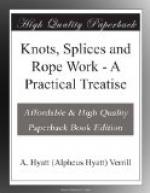[Illustration: FIG. 23.—Weaver’s knot (tying).]
Another useful and handsome knot is illustrated in Fig. 24. This is a variation of the figure-eight knot, already described, and is used where there is too much rope, or where a simple knot is desired to prevent the rope running through an eye, ring, or tackle-block. It is made by forming a regular figure eight and then “following round” with the other rope as in Fig. 25. It is then drawn taut and the ends seized to the standing part if desired.
[Illustration: FIG. 24.—Double figure-eight knot (complete).]
[Illustration: FIG. 25.—Double figure-eight knot (tying).]
Sometimes we have occasion to join two heavy or stiff ropes or hawsers, and for this purpose the “Garrick Bend” (Fig. 26) is preeminently the best of all knots. To make this knot, form a bight by laying the end of a rope on top of and across the standing part. Next take the end of the other rope and pass it through this bight, first down, then up, over the cross and down through the bight again, so that it comes out on the opposite side from the other end, thus bringing one end on top and the other below, as illustrated in Fig. 27. If the lines are very stiff or heavy the knot may be secured by seizing the ends to the standing parts. A much simpler and a far poorer knot is sometimes used in fastening two heavy ropes together. This is a simple hitch within a loop, as illustrated in Fig. 28, but while it has the advantage of being quickly and easily tied it is so inferior to the Garrick bend that I advise all to adopt the latter in its place.
[Illustration: FIG. 26.—Garrick bend (finished).]
[Illustration: FIG. 27.—Garrick bend (tying).]
[Illustration: FIG. 28.—Simple hitch (hawser).]
When two heavy lines are to be fastened for any considerable time, a good method is to use the “Half-hitch and Seizing,” shown in Fig. 29. This is a secure and easy method of fastening ropes together and it allows the rope to be handled more easily, and to pass around a winch or to be coiled much more readily, than when other knots are used.
[Illustration: FIG. 29.—Half-hitch and seizing.]
CHAPTER III
TIES AND HITCHES
All the knots I have so far described are used mainly for fastening the two ends of a rope, or of two ropes, together. Of quite a different class are the knots used in making a rope fast to a stationary or solid object, and are known as “hitches” or “ties.”
One of the easiest of this class to make and one which is very useful in fastening a boat or other object where it may be necessary to release it quickly is the “Lark’s Head” (Fig. 30). To make this tie, pass a bight of your rope through the ring, or other object, to which you are making fast and then pass a marline-spike, a billet of wood, or any similar object through the sides of the bight




